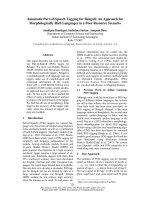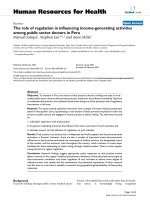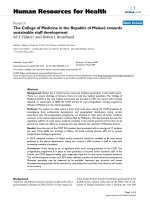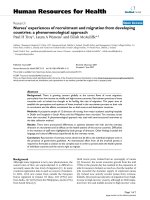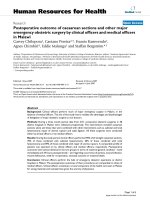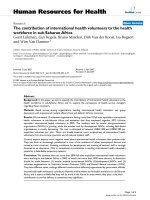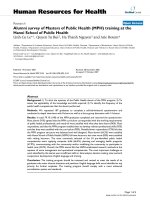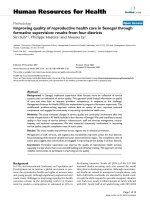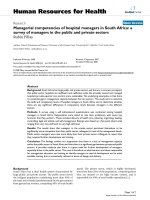Báo cáo sinh học: "Autologous Transplantation of Adipose-Derived Mesenchymal Stem Cells Markedly Reduced Acute Ischemia-Reperfusion Lung Injury in a Rodent Model" potx
Bạn đang xem bản rút gọn của tài liệu. Xem và tải ngay bản đầy đủ của tài liệu tại đây (4.32 MB, 13 trang )
RESEARCH Open Access
Autologous Transplantation of Adipose-Derived
Mesenchymal Stem Cells Markedly Reduced
Acute Ischemia-Reperfusion Lung Injury in a
Rodent Model
Cheuk-Kwan Sun
1,2†
, Chia-Hung Yen
3†
, Yu-Chun Lin
4,5
, Tzu-Hsien Tsai
5
, Li-Teh Chang
6
, Ying-Hsien Kao
7
,
Sarah Chua
5
, Morgan Fu
5
, Sheung-Fat Ko
8
, Steve Leu
4,5*
and Hon-Kan Yip
4,5*
Abstract
Background: This study tested the hypothesis that autologous transplantation of adipose-derived mesenchymal
stem cells (ADMSCs) can effectively attenuate acute pulmonary ischemia-reperfusion (IR) injury.
Methods: Adult male Sprague-Dawley (SD) rats (n = 24) were equally randomized into group 1 (sham control),
group 2 (IR plus culture medium only), and group 3 (IR plus intravenous transplantation of 1.5 × 10
6
autologous
ADMSCs at 1h, 6h, and 24h following IR injury). The duration of ischemia was 30 minutes, followed by 72 hours of
reperfusion prior to sacr ificing the animals. Blood samples were collected and lungs were harvested for analysis.
Results: Blood gas analysis showed that oxygen saturation (%) was remarkably lower, whereas right ventricular
systolic pressure was notably higher in group 2 than in group 3 (all p < 0.03). Histological scoring of lung
parenchymal damage was notably higher in group 2 than in group 3 (all p < 0.001). Real time-PCR demonstrated
remarkably higher expressions of oxidative stress, as well as inflammatory and apoptotic biomarkers in group 2
compared with group 3 (all p < 0.005). Western blot showed that vascular cell adhesion molecule (VCAM)-1,
intercellular adhesion molecule (ICAM)-1, oxidative stress, tumor necrosis factor-a and nuclear factor-B were
remarkably higher, whereas NAD(P)H quinone oxidoreductase 1 and heme oxygenase-1 activities were lower in
group 2 compared to those in group 3 (all p < 0.004). Immunofluorescent stain ing demonstrated notably higher
number of CD68+ cells, but significantly fewer CD31+ and vWF+ cells in group 2 than in group 3.
Conclusion: ADMSC therapy minimized lung damage after IR injury in a rodent model through suppressing
oxidative stress and inflammatory reacti on.
Background
The lung maintains its unique function of effect ive gas-
eous exchange because of its remarkably large alveolar
surface area, its rich and delicate alveolar capillary net-
work, as well as its physical properties (i.e. elasticity and
compliance). On the other hand, it is vulnerable to
acute ischemia-reperfusion (IR) injury in situations such
as resuscitation from hemorrhagic/septic shock and
recovery from cardiac surgeries where pulmonary blood
supplies have to be clamped, and also after lung trans-
plantation [1-4]. Inflammatory cells have been reported
to be the key coordinators of IR-elicited pulmonary
injury in response to inflammatory response and oxida-
tive stress [5-7]. Additionally, the productions of reactive
oxygen species (ROS), pro-inflammatory cytokines, and
adhesion molecules have also been found to be crucial
contributors to lung IR injury [6,8-12].
Acute lung injury of different etiologies is known to
be associated with high in-hospital morbidity and mor-
tality [13-15]. Previous studies have shed some light on
several potential therapeutic strategies includi ng the use
* Correspondence: ;
† Contributed equally
4
Center for Translational Research in Biomedical Sciences, Kaohsiung Chang
Gung Memorial Hospital and Chang Gung University College of Medicine,
Kaohsiung, Taiwan
Full list of author information is available at the end of the article
Sun et al . Journal of Translational Medicine 2011, 9:118
/>© 2011 Sun et al; licensee BioMed Central Ltd. This is an Open Access article distributed under the terms of the Creative Commons
Attribution License ( y/2.0), which permits unrestricted use, distributio n, and reproduction in
any medium, provided the original work is properly cited.
of aprotinin [4], N-acetyl-L-cysteine [16], hypothermia
[17], and inhalational nitric oxide [18]. However, the
effectiveness of these treatment modalities is still uncer-
tain. A safe and effective therapeutic regimen for
patients with acute lung injury, therefore, is eagerly
awaited.
Accumulating evidence from studies on animal mod-
els and human pulmonary tissue have shown that
mesenchymal stem cell (MSC) therapy is of noteworthy
potential in improving pulmonary functions in various
settings of lung diseases, including acute lung injury
[19-23]. In addition to regulating angiogenic [24] and
pro-inflammatory [25,26] cytokines associated with
MSC treatment, other proposed mechanisms including
suppression of inflamma tory reaction, immunomodula-
tion, and repair of damaged epithelial cells have also
been sug gested [19-25]. Interestingly, alt hough the ben-
efits of MSC therapy in improving bleomycin- and
endotoxin-induced acute or chronic lung injury using
animal models have been extensively investigated
[22,24-27], the effect of MSC therapy on IR-induced
pulmonary injury in experimental models has seldom
been reported [23]. Besides, although bone marrow-
derived MSC is the major source of stem cells in these
studies [22,24-27], the therapeutic role of adipose-
derived mesenchymal stem cells (ADMSCs) in acute IR
injury of the lung has not been investigated. Recently,
ADMSCs have been reported to have the distinct
advantages of being abundant, easy to obtain with mini-
mal invasiveness, and readily cultured to a sufficient
number for autologous transplantation without ethical
issue of allografting [28]. Moreover, it has been demon-
strated that, compared with bone marrow-derived
MSCs, ADMSCs s ecrete significantly more bioactive
factors that may account for their superior anti-inflam-
matory and regeneration-enha ncing properties [29].
Since the mechanisms involved in IR injuries of solid
organs are complicated including the generation of ROS
[30], mitochondrial damage [31,32], and a cascade of
inflammatory processes [5-7], similar pathogenesis are
supposed to account at least partly for the observed IR
injury of the lung. Hence, we hypothesized that admin-
istration of ADMSCs has a positive therapeutic impact
on pulmonary IR injury at cellular, molecular, and func-
tional levels.
Methods
Ethic
All experimental animal procedures were approved by
the Institute of Animal Care and Use Committee at
Kaohsiung Chang Gung Memorial Hospital (Affidavit of
Approval of Animal Use Protocol No. 2008121108) and
performed in accordance with the Guide for the Care
and Use of Laboratory Animals ( NIH publication No.
85-23, National Academy Press, Washington, DC, USA,
revised 1996).
Animal Grouping and Isolation of Adipose-Derived
Mesenchymal Stem Cells
Pathogen-free, adult male Sprague-Dawley (SD) rats (n
= 24) weigh ing 300-325 g (Charles River Technology,
BioLASCO Taiwan Co., Ltd., Taiwan) were randomized
into group 1 (sham control, n = 8), group 2 (IR plus
culture medium, n = 8) and group 3 (IR plus autologous
ADMSC infusion, n = 8) before isolation of ADMSCs.
The rats in g roup 3 were anesthetized with inhala-
tional isoflurane 14 days before induction of IR in jury.
Adipos e tissue surrounding the epididym is was carefully
dissected, excised and prepared based on our recent
report [28]. Then 200-300 μL of sterile saline was added
to every 0.5 g of adipose tissue to prevent dehydration.
Thetissuewascutinto<1mm
3
pieces using a pair of
sharp, sterile surgical scissors. Sterile saline (37°C) was
added to the homogenized adipose tissue in a ratio of
3:1 (saline: adipose tissue), followed by the addition of
stock collagenase solution to a final concentration of 0.5
units/mL. The centrifuge tubes with the contents were
placed and secured on a Thermaline shaker and incu-
bated with constant agitation for 60 ± 15 minutes at 37°
C. After 40 minutes of incubation, the content was tritu-
rated with a 25 mL pipette for 2-3 minutes. The cells
obtained were placed back to the rocker for incubation.
The contents of the flask were transferred to 50 mL
tubes after digestion, followed by centrifugation at 600 g
for 5 minutes at room temperature. The fatty layer and
saline supernatant from the tube were poured out gently
in one smooth motion or removed using vacuum suc-
tion. The cell pellet thus obtained was resuspended in
40 mL saline and then centrifuged again at 600 g for 5
minutes at room temperature. After being resuspended
againin5mLsaline,thecellsuspension was filtered
through a 100 μm filter into a 50 mL conical tube to
which 2 mL of saline was added to rinse the remaining
cells through the filter. The flow-through was p ipetted
into a new 50 mL conical tube through a 40 μm filter.
The tubes were centrifuged for a third ti me at 600 g for
5 minutes at room temperature. The cells were resus-
pended in saline. An aliquot of cell susp ension was th en
removed for cell culture in Dulbecco’s modified Eagle’s
medium (DMEM)-low glucose medium containing 10%
FBS for 14 days. Approximately 5.5 × 10
6
ADMSCs
were obtained from each rat. Flow cytometric analysis
was performed for identification of cellular characteris-
tics after cell-labeling with appropriate antibodies on
day 0 before cell culture and on day 14 prior to trans-
plantation (Table 1).
To determine whether culturing ADMSCs had anti-
inflammatory and immunomodulatory properties,
Sun et al . Journal of Translational Medicine 2011, 9:118
/>Page 2 of 13
another 6 rats were used in the current study. The
ADMSCs on da y 0 prior to and on day 14 af ter cultiva-
tion were utilized for analyzing the mRNA expressions
of interleukin (IL)-10, IL-4, adiponectin and interferon-g
using RT-PCR, respectively.
ADMSC Labeling with CM-Dil, Protocol of IR Induction,
and Autologous ADMSC Administration
By day 14 prior to ADMSC infusion, all animals were
anesthetized by chloral hydrate (35 mg/kg i.p.) plus inha-
lational isoflurane and placed in a supine position on a
warming pad at 37°C, followed by endotracheal intuba-
tion with positive-pres sure ventilation (180 mL/min)
with room air using a Small Animal Ventilator (SAR-
830/A, CWE, Inc., USA). Under sterile conditions, the
lung was exposed via a left thoracotomy. Lung IR was
then conducted in group 2 and group 3 animals on
which a left thoracotomy was performed with the left
main bronchus and blood supplies to the l eft lung totally
clamped for 30 minutes using non-traumatic vascular
clips before reperfusion for 72 hours. Successful clamping
was confirmed by the observation of a lack of inflation of
the left lung on mechanical ventilation. Sham-operated
rats subjected to left thoracotomy only served as normal
controls. The CM-Dil (Vybrant™ Dil cell-labeling solu-
tion, Molecular Probes, Inc.) (50 μg/mL) was added to
the culture medium 30 minutes before IR procedure for
ADMSC labeling. After completion of ADMSC labeling,
intravenous infusion of autologous ADMSCs (1.5 × 10
6
)
was performed 60 minutes, 6 hours, and 24 hours after
reperfusionviathepenilevein.ThedosageofADMSCs
utilized in the current study was based on our recent
reports [33,34]. All animals were sacrificed 72 hours after
lung reperfusion after measurement of right ventricular
systolic blood pressure (RVSBP). The left lungs were col-
lected for subsequent studies.
Determination of Oxygen Saturation and Right
Ventricular Systolic Blood Pressure (RVSBP)
To determine the effect of ADMSC therapy on arterial
oxygen saturation (Sat O
2
), carotid arterial blood gas
was analyzed prior to left thoracotomy and at 72 h after
the IR procedure. RVSBP, an indicator of pulmonary
arterial blo od pressure, was assessed at 72 h after the IR
procedure prior to sacrificing the animals.
For RVSBP me asurement, each animal was endotra-
cheally intubated with positive-pressure ventilation (180
mL/min) with r oom air using a small animal ventilator.
The detailed procedure has been described in our recent
report [33]. Briefly, the heart was exposed by left thora-
cotomy. A sterile 20-gauge, soft-plastic coated needle
was inserted into the ri ght ventricle and femoral artery
of each rat to measure the RVSBP and systemic arterial
pressure, respectively. The p ressure signals were first
transmitted to pressure transducers (UFI, model 1050,
CA, U.S.A.) and then exported to a bridge amplifier
(ML866 PowerLab 4/30 Data Acquisition Systems.
ADInstruments Pty Ltd. , Castle Hill, NSW, Australia)
where the signals were amplified and digitized. The data
were recorded and later analyzed with the Labchart soft-
ware (ADInstrument). After hemodynamic measure-
ments, the rats were euthanized with the hearts and
lungs harvested. Half of the left lung was fixed in 4%
formaldehyde and then embedded in paraffin blocks,
while the rest was cut into pieces, frozen in liquid nitro-
gen and then stored at -80° C until future use.
Identification of Alveolar Sac Distribution in Lung
Parenchyma
Left lung specimen s from all animals were fixed in 10% buf-
fered formalin before embedding in paraffin and the tissue
was sectioned at 5 μm for light microscopic analysis. After
hematoxylin and eosin (H & E) staining, the number of
alveolar sacs was determined i n a blinded fashion a ccording
to our recent study [33]. Three lun g sections from each rat
were analyzed and three randomly selected high-power
fields (HPFs) (100×) were examined in each section. The
mean number per HPF for each animal was then deter-
mined by summation of all numbers divided b y 9.
Immunofluorescent (IF) Studies and Crowded Score of
Lung Parenchyma
IF staining was performed for the examinations of CD68
(macrophage surface marker)+, CD31+, and von
Table 1 Flow Cytometric Analysis of Adipose-Derived
Mesenchymal Stem Cell Surface Markers Prior to (Day1)
and Following Cell Culture (Day 14)
Surface markers Day 1 Day 14 p-value†
CD31+ 22.0 ± 3.5 19.3 ± 6.8 0.563
CD34+ 14.1 ± 7.8 15.1 ± 14.9 0.844
KDR+ 19.7 ± 2.5 17.4 ± 8.2 0.438
C-kit+ 3.13 ± 1.80 2.40 ± 1.24 0.563
Sca-1+ 3.22 ± 1.49 2.72 ± 2.10 0.688
VEGF+ 14.3 ± 5.2 14.7 ± 8.7 1.0
vWF+ 15.9 ± 7.6 15.9 ± 7.1 1.0
CD26+‡ 18.0 ± 3.7 4.7 ± 4.4 0.031
CD45+¶ 14.1 ± 12.5 11.6 ± 12.0 0.844
CD271+ 18.4 ± 5.7 16.6 ± 7.6 0.688
CD29+ 23.7 ± 8.7 91.4 ± 7.1 0.031
CD90+ 35.2 ± 5.8 88.1 ± 10.9 0.031
Data are expressed as %.
n = 6 in each experimental study.
† by Wilcoxon signed rank test for paired data.
‡ Dipeptidyl peptidase IV (DPP-IV)/CD26 indicates a cell surface glycoprotein.
¶ Leukocyte common antigen.
KDR = Kinase insert domain receptor; VEGF = vascular endothelial growth
factor; vWF = von Willebrand Factor.
Sun et al . Journal of Translational Medicine 2011, 9:118
/>Page 3 of 13
Willebrand factor (vWF)+ cells usin g respective primary
antibodies. Irrelevant antibodies were used as controls
in the current study.
The extent of crowde d area , which was defined as the
region of thickened septa in lung parenchyma associated
with partial or complete collapse of alveoli on H & E-
stained sections, was determined in a blinded fashion.
The scoring system adopted was as follows: 0 = no
detectable crowded area; 1 = <15% of crowded area; 2 =
15-25% of crowded area; 3 = 25-50% of cr owded area; 4
= 50-75% of crowded area; 5 = >75%-100% of c rowded
area/per high-power field (100 x).
Western Blot Analysis of Left Lung Specimens
Equal amounts (10-30 mg) of protein extracts from the
left lung were loaded and separated by SDS-PAGE using
8-10% acrylamide gradients. Following electrophoresis,
the separated proteins were transferred electrophoreti-
cally to a polyvinylidene difluoride (PVDF) membrane
(Amersham Biosciences). Nonspecific proteins were
blocked by incubating the membrane in blocking buffer
(5% nonfat dry milk in T-TBS containing 0.05% Tween
20) overnight. The membranes were incubated with
monoclonal antibodies against vascular cell adhesion
molecule (VCAM)-1 (1: 100, Abcam, Cambridge, MA,
USA), intercellular adhesion molecule (ICAM)-1 (1:
2000, Abcam, Cambridge, MA, USA), NAD(P)H qui-
noneoxidoreductase(NQO)-1(1:1000,Abcam,Cam-
bridge, MA, USA), connexin43 (Cx43) (1: 2000,
Chemicon, Billerica, MA, USA), cytochrom C (Cyt C)
(1: 2000, BD, San Jose, CA, USA) and heme oxygense
(HO)-1 (1: 250, Abcam, Cambridge, MA, USA), and
polyclonal antibodies against TNF-a (1: 1000, Cell Sig-
naling, Danvers, MA, USA) and NFB (1: 250, Abcam,
Cambridge, MA, USA). Signals were detected with
horseradish peroxidase (HRP)-conjugated goat anti-
mouse, goat anti-rat, or goat anti-rabbit IgG.
The Oxyblot Oxidized Protein Detection Kit was pur-
chased from Chemicon (S7150). The procedure of 2,4-
dinitrophenylhydrazine (DNPH) derivatization was car-
ried out on 6 μg of protein for 15 minutes according to
manufacturer’ s instructions. One-dimensional electro-
phoresis was carried out on 12% SDS/polyacrylamide gel
after DNPH derivatization. Proteins were transferred to
nitrocellulose membranes which were then i ncubated in
the primary antibody solution (anti-DNP 1: 150) for two
hours, followed by incubation with secondary antibody
solution (1:300) for one hour at room temperature. The
washing procedure was repeated eight times within 40
minutes.
Immunoreactive bands were visualized by enhanced
chemiluminescence (ECL; Amersham Biosciences)
which was then exposed to Biomax L film (Kodak). For
quantification, ECL signals were digitized using Labwork
soft ware (UVP). For oxyblot protein analysis, a standard
control was loaded on each gel.
Real-Time Quantitative PCR Analysis
Real-time polymerase chain reaction (RT-PCR) was per-
formed using LightCycler TaqMan Master (Roche, Ger-
many) in a single capillary tube according to the
manufacturer’ s instructions for individual component
concentrations. Forward and reverse primers were each
designed based on individual exons of the target gene
sequence to avoid amplifying genomic DNA.
During PCR, the probe was hybridized to its comple-
mentary single-strand DNA sequence within the PCR
target. As amplification occurred, the probe was
degraded due to the exonuclease activity of Taq DNA
polymerase, thereby separating the quencher from
reporter dye during extension. During the entire amplifi-
cation cycle, light emission increased exponentially. A
positive result was determined by identifying the thresh-
old cycle v alue at which reporter dye emission appeared
above background.
Statistical Analysis
Quantitative data are expressed as means ± SD. Statisti-
cal analysis was adequately performed by ANOVA fol-
lowe d by Bonferroni multi ple-comparison post hoc test.
Statistical analysis was performed using SAS statistical
software for Windows version 8.2 (SAS institute, Cary,
NC). A probability value <0.05 was considered statisti-
cally significant.
Results
Flow Cytometric Analyses of Adipose-Derived
Mesenchymal Stem Cell Surface Markers
Cell surface marker study demonstrated the presence of
both endothelial progenitor cells (EPCs) (i.e. CD31+,
CD34+,KDR+,Sca-1,C-kit,vWF,VEGF)andMSCs
(CD26+, CD2 9+, CD45+, CD90+, CD2 71+) prior to and
14 days after cell c ulturing (Table 1). The percentages
of all EPC surface markers were similar between day 0
and day 14 of cell culture. Additionally, the percentages
of MSC surface markers of CD45+ and CD271+ cells
did not differ between day 0 and day 14 of cell culture.
However, compared with day 0, the percenta ge of c ells
positive for MSC surface marker CD26 was signif icantly
decreased after 14 days of cell culture. In contrast, the
percentages of cells positive for MSC surface markers
CD29 and CD90 were substantially increased after cell
culture for 14 days. These findings, therefore, indicate
that adipocytes from adipose tissue can differentiate into
EPCs and ADMSCs in Dulbecco’s modified Eagle’s med-
ium (DMEM) (containing 10% fetal bovine serum) cul-
ture medium. The majority of these cells differentiated
into ADMSCs instead of EPCs.
Sun et al . Journal of Translational Medicine 2011, 9:118
/>Page 4 of 13
Arterial Oxygen Saturation and Right Ventricular Systolic
Blood Pressure (RVSBP)
Sat O
2
did not differ among control rats (group 1), IR
rats (group 2), and IR + ADMSC-treated rats (group 3)
prior to the IR procedure (94% vs. 94.3% vs. 93.7%, p >
0.5). However, Sat O
2
was significantly higher in group
1 than in groups 2 and 3, and notably higher in group 3
than in group 2 at 72 h after the IR procedure (Figure
1A). On the other hand, RVSBP was notably lower in
groups 1 and 3 than i n group 2, and remarkably higher
in group 3 than in group 1 (Figure 1B). These findings
indicate that IR injury in the experimental model was
successfully created and that ADMSC treatment signifi-
cantly attenuated IR-elicited lung injury.
Histopathologic Findings of the Lung
To evaluate the impact of ADMSC transplantation on
the severity of IR-induced lung parenchymal injury, H &
E-stained lung sections were e xamined (Figure 2, A-C).
The number of alveol ar sacs in left lung was substan-
tially fewer in group 2 than in groups 1 and 3, and nota-
bly fewer in group 3 than in group 1 at 72 h after IR
(Figure 2D). By contrast, the lung paren chyma was
remarkably crowded in group 2 compared with that in
groups 1 and 3, and was significantly more crowded in
group 3 compared to group 1 (F igure 2E). Additionally,
septum thickening was more frequently observed in
group 2 than in group s 1 and 3, and this phenomenon
wasalsomorefrequentlypresentingroup3thanin
group 1. These findings, therefore, suggest that ADMSC
therapy significantly protected lung parenchyma from IR
damage.
Figure 1 Arterial Oxygen Saturation and Systolic Blood
Pressure in Right Ventricle at 72 Hour after the Procedure. (A)
Arterial oxygen saturation (Sat O
2
) at 72 h after ischemia-reperfusion
(IR) injury. *p < 0.01 between the indicated groups (n = 8). (B) Right
ventricular systolic blood pressure (RVSBP). *p < 0.01 between the
indicated groups. ADMSC: Adipose-derived mesenchymal stem cells.
Symbols (*, †, ‡) indicate significance (at 0.05 level) (by Bonferroni
multiple comparison post hoc test).
Figure 2 Impact of Adipose-Derived Mesenchymal Stem Cells
(ADMSC) Transplantation on the Severity of IR-Induced Lung
Parenchymal Injury. Number of alveolar sacs and crowded area
(was defined in methodology section) under microscope (100×) at
72 h following ischemia-reperfusion (IR) procedure (n = 6). Notably
reduced number of alveolar sacs in IR group (B) compared with IR
+ ADMSC (C) and normal control (A) groups (H & E). Also note
more compact lung parenchyma with thickened septum in IR
group than in other groups. Septal thickening more prominent in
some alveoli in IR group than in IR + ADMSC and normal control
groups. Scale bars in right lower corner represent 100 μm. D) *p <
0.001 between the indicated groups. E) *p < 0.0001 between the
indicated groups. Symbols (*, †, ‡) indicate significance (at 0.05
level) (by Bonferroni multiple comparison post hoc test).
Sun et al . Journal of Translational Medicine 2011, 9:118
/>Page 5 of 13
ADMSC Transplantation Attenuated Gene Expression
(mRNA) as Related to Vasoconstriction, Inflammation,
Oxidative Stress, and Apoptosis in Lung Parenchyma after
IR Injury
The mRNA e xpressions of interleukin (IL)-1b,tumor
necrosis factor (TNF)-a and matrix metalloproteinase
(MMP)-9, three indicator s of inflammation, were
remarkably higher in group 2 than in groups 1 and 3,
and notably higher in group 3 than in group 1 (Figure
3, A-C). Conversely, the mRNA expressions of en dothe-
lial nitric oxide synthase (eNOS), IL-10, and adiponec-
tin, the i ndexes of anti-inflammation, were notably
loweringroup2thaningroups1and3,andsignifi-
cantly lower in group 3 than in group 1 (F igure 3, D-F).
These findings imply that ADMSC treatment inhibited
inflammatory reaction in this experimental setting.
The mRNA expressions of heme oxygenase (HO)-1,
NAD(P)H quinone oxidoreductase (NQO) 1, glutathione
reductase (GR), and glutathione peroxidase (GPx), four
anti-oxidative indicators, were remarkably lower in
group 2 than in groups 1 and 3, and notably lower in
group 3 than in group 1 (Figure 3, G-J). These findings
suggest an induction of anti-oxidative response after IR
injury and an enhancement of anti-oxidant effect
through ADMSC administration.
The mRNA expressions of caspase 3 and Bax, two
pro-apoptotic indexes, were markedly higher in group 2
than those in groups 1 and 3, and notably increased in
group 3 compared with those in group 1 (Figure 3, K
and 3L). By contrast, the mRNA expression of Bcl-2, an
index of anti-apoptosis, was remarkably lower in group
2 than in groups 1 and 3, and significantly reduced in
group 3 than in group 1 (Figure 3M). These findings
imply that ADMSC treatment exerted anti-apoptotic
and mitochondria-protective effects.
The mRNA expression of endo thelin (ET)-1, an index
of endothelial vasoconstriction and impaired perfusion,
was notably higher in group 2 than in groups 1 and 3
and significantly higher in group 3 than in group 1 (Fig-
ure 3N). These findings indicate that IR-induced
endothelial damage of lung was significantly suppressed
after ADMSC treatment.
Presence of CD31+ von Willebrand Factor (vWF)+ and
CD68+ Cells in Lung Parenchyma
Fluorescent microscopy revealed expressions of CD31
(Figure 4, A-D) and vWF (Figure 4, E-H), indicators of
endothelial cellular phenotypes, in some cells located
in lung parenchyma. These findings suggest that angio-
genesis occurred in the lung for possible repair of IR
injury and tissue regeneration after AMDMSC
transplantation.
Immunofluorescent staining demonstrated substan-
tially higher number of CD68+ cells (Figure 5, A-D), a
macrophage marker, in group 2 than in groups 1 and 3.
The number was also and notably higher in group 3
than in group 1. This finding implies that ADMSC
treatment suppressed recruitment of inflammato ry cells
to pulmonary tissue after IR.
ADMSC Treatment Inhibited Inflammation and Reactive
Oxygen Species Generation in Lung Parenchyma after IR
Injury–Assessment at Protein Level
Western blot analyses demonstrated notably higher pro-
tein expressions of VCAM-1, ICAM-1 (Figure 5 , E and
5F), TNF-a, and NF-B (Figure 6, A and 6B), four acute
inflammatory biomar kers, in group 2 than those in
groups 1 and 3, and in group 3 compar ed with those in
group 1 following ac ute lung IR injury. In addition, the
protein expression of oxidative stress (Figure 6C), an
indicator of ROS activity, was increased several folds in
group 2 compared with that i n groups 1 and 3, and sig-
nificant higher in group 3 than that in group 1. In con-
trast, the protein expressions of HO-1 and NQO-1
(Figure 6, D and 6E), two anti-oxidative biomarkers,
were remarkably higher in group 3 than those in groups
1 and 2, and significantly higher in group 2 than those
in group 1. These findings further suggest that ADMSC
treatment contributed to the anti-inflammatory and
anti-oxidative effects after IR-induced pulmonary injury
in this study.
Protein overexpression of Cx43 (Figure 7A), an index
of smooth muscle proliferation after an acute injury,
was remarkably higher in group 2 than that in g roups 1
and 3, and significantly higher in group 3 than that in
group 1. Besides, mitochondrial cytochrome c (Figure
7B), an index of mitochondrial integrity, was notably
reduced in group 2 compar ed with that in groups 1 and
3, but it did not differ between group 1 and group 3.
On the other hand, an increase of cytochrome c in cyto-
sol (Figure 7C), an index of mitoc hondrial damage, was
notably higher in group 2 than that in groups 1 and 3.
However, no significant difference was noted between
group1 and group 3. These findings further suggest that
ADMSC therapy protected lung parenchyma from IR
damage, possibly through suppression of smooth muscle
proliferative response and preservation of mitochondrial
integrity.
Discussion
Thi s study, which utili zed a rodent model to investigate
the therapeutic impact of ADMSC treatment on IR-eli-
cited acute lung injury, provided several striking impli-
cations. First, not only did ADMSC treatment
sig nificantly preserve architectural integrity of lung par-
enchyma, but it also remarkably reduced the deteriora-
tion of pulmonary function after IR injury. Second,
ADMSC therapy significantly ameliorated IR-induced
Sun et al . Journal of Translational Medicine 2011, 9:118
/>Page 6 of 13
Figure 3 Analysis of mRNA Expressions of IL-1 b, TNF-a, MMP-9, eNOS, IL-10, Adiponectin, HO-1, NQO 1, GR, GPx, Caspase 3, Bax, Bcl-2
and ET-1 in Lung Parenchyma after IR Injury. Real-time quantitative PCR for gene expression (n = 8). (A) Interleukin (IL)-1b mRNA expression.
*p < 0.04 between the indicated groups. (B) Tumor necrosis factor (TNF)-a mRNA expression. *p < 0.05 between the indicated groups. (C)
Matrix metalloproteinase (MMP)-9 mRNA expression. *p < 0.04 between the indicated groups. (D) Endothelial nitric oxide synthase (eNOS) mRNA
expression. *p < 0.04 between the indicated groups. (E) IL-10 mRNA expression. *p < 0.05 between the indicated groups. (F) Adiponectin mRNA
expression. *p < 0.04 between the indicated groups. (G) Heme oxygenase (HO)-1 mRNA expression. *p < 0.03 between the indicated groups. (H)
NAD(P)H quinone oxidoreductase (NQO)-1 mRNA expression. *p < 0.02 between the indicated groups. (I) Glutathione reductase (GR) mRNA
expression. *p = 0.01 between the indicated groups. (J) Glutathione peroxidase (GPx) mRNA expression. *p < 0.03 between the indicated groups.
(K) Caspase 3 mRNA expression. *p < 0.03 between the indicated groups. (L) Bax mRNA expression. *p < 0.03 between the indicated groups.
(M) Bcl-2 mRNA expression. *p < 0.02 between the indicated groups. (N) Endothelin (ET)-1 mRNA expression. *p < 0.03 between the indicated
groups. Symbols (*, †, ‡) indicate significance (at 0.05 level) (by Bonferroni multiple comparison post hoc test).
Sun et al . Journal of Translational Medicine 2011, 9:118
/>Page 7 of 13
pulmonary artery hypertension. Third, ADMSC treat-
ment was associated with early-onset anti-inflammatory,
anti-oxidative, a nd pro-angiogenic effects in pulmonary
tissue after IR injury.
ADMSC Transplantation Ameliorates Inflammation and
Oxidative Stress, and Attenuates Apoptosis and
Architectural Damage in Lung Following Acute IR Injury –
Role of Immune Modulation
Undoubtedly, the lung is vulnerable to damage through
a variety of etiolo gies because of its distinctive anatomi-
cal feature, circulation, and its unique f unction in gas-
eous exchange [1-4]. Besides, similar to the central
nervous system and myocardium, the lung has only
minimal ability of regeneration after injuries. In addi-
tion, ROS production, immune response, and inflamma -
tory reaction elicited by a primary insult are usually
rigorous and cause irreversible secondary damage to the
lung parenchyma [5-15]. The appropriate treatment
Figure 4 Presence of CD31+ and von Willebrand Factor (vWF)
Cells in Lung Parenchyma. (Upper Panel) Immunofluorescent (IF)
staining (200 x) of CD31+ cells with green color in lung
parenchyma. Notably fewer number of CD31+ cells (white arrows)
in ischemia-reperfusion (IR) group (B) than in normal control (A)
and IR + adipose-derived mesenchymal stem cell (ADMSC) (C)
groups. C) Merged picture from double staining (Dil + CD31)
showing mixed color of red and yellow cells [under high
magnification (a) of the dotted box (b)], indicating implanted CD31-
positive cells presented in lung the lung parenchyma. D) *p < 0.01
between the indicated groups. (Lower Panel) IF staining (200 x) of
von Willebrand factor (vWF)+ cells with green color in lung
parenchyma. Notably reduced number of vWF+ cells (white arrows)
in IR group (F) than in normal control (E) and IR + ADMSC (G)
groups. G) Merged picture from double staining (Dil + CD31)
showing mixed color of red, green, and yellow cells [under high
magnification (c) of the dotted box (d)], indicating the presence of
implanted vWF-positive cells in lung parenchyma. H) *p < 0.001
between the indicated groups. Symbols (*, †, ‡) indicate significance
(at 0.05 level) (by Bonferroni multiple comparison post hoc test).
Scale bars in right lower corner represent 50 μm. n = 6 in each
group.
Figure 5 Adipose-Derived Mesenchymal Stem Cell (ADMSC)
Treatment Inhibited Inflammation in Lung Parenchyma after IR
Injury. (Upper Panel) Immunofluorescent (IF) staining (200 x) of
CD68+ cells (n = 6). Note the notably higher number of CD68+
cells (yellow arrows) in ischemia-reperfusion (IR) group (B) than in
normal-control (A) and IR + ADMSC (C) groups. D) *p < 0.001
between the indicated groups. Scale bars in right lower corner
represent 50 μm. (Lower Panel) Western blot analyses showing
significantly higher protein expressions of intercellular adhesion
molecule (ICAM)-1 (E) and vascular adhesion molecule (VCAM)-1 (F)
in IR group than in other groups. E) *p < 0.03 between the
indicated groups. F) *p < 0.05 between the indicated groups.
Symbols (*, †, ‡) indicate significance (at 0.05 level) (by Bonferroni
multiple comparison post hoc test).
Sun et al . Journal of Translational Medicine 2011, 9:118
/>Page 8 of 13
strategy toward acute lung injury, therefore , is a formid-
able challenge to physicians.
Experimental studies have recently shown that therapy
with bone marrow-derived MSCs markedly attenuated
endotoxin- or belomycin-induced lung injury through
suppressing the generation of pro-inflammatory cyto-
kines and inflammatory reaction [19-23,25,26]. One
Figure 6 Adipose-Derived Mesenchymal Stem Cell (ADMSC)
Treatment Inhibited Inflammation and Reactive Oxygen
Species Generation in Lung Parenchyma after Ischemia-
Reperfusion (IR) Injury. Notably higher protein expressions of TNF-
a (A) and NF-B (B) in IR group than in normal control and IR +
ADMSC groups, but lack of difference between normal control and
IR + ADMSC groups. *all p values < 0.04 between the indicated
groups. Western blotting (C) showing notable increase in the
oxidative index, protein carbonyls, in IR group compared with
control group and IR + ADMSC group, and notably higher in IR +
ADMSC group than in control group. *p < 0.05 between the
indicated groups. Remarkably higher protein expressions of HO-1
(D) and NQO-1 (E) in IR and IR + ADMSC groups than in control
group, and markedly higher in IR + ADMSC group than in IR group.
*all p values < 0.04 between the indicated groups. n = 6 for each
group. Symbols (*, †, ‡) indicate significance (at 0.05 level) (by
Bonferroni multiple comparison post hoc test).
Figure 7 Adipose-Derived Mesenchymal Stem Cell (ADMSC)
Treatment Inhibited apoptosis in Lung Parenchyma after
Ischemia-Reperfusion (IR) Injury. Notably elevated protein
expression of connexin (Cx)43 in IR group than in normal control
and IR + ADMSC group, and higher in IR + ADMSC group than in
normal control group. *p < 0.04 between the indicated groups. B)
Notably suppressed mitochondrial protein expression of cytochrome
c in IR group than in normal-control and IR + ADMSC group, and
higher in IR + ADMSC group than in normal control group. *p <
0.03 between the indicated groups. C) Remarkably enhanced
cytosolic protein expression of cytochrome C (Cyt C) in IR group
than in normal control and IR + ADMSC group, and higher in IR +
ADMSC group than in normal control group. *p < 0.03 between the
indicated groups. Symbols (*, †, ‡) indicate significance (at 0.05
level) (by Bonferroni multiple comparison post hoc test). n = 6 for
each group. COIV=cytochrome oxidase subunit IV.
Sun et al . Journal of Translational Medicine 2011, 9:118
/>Page 9 of 13
important finding in the current study is that the mRNA
expressions of IL-1b,TNF-a, and MMP-9 as well as the
protein expressions of ICAM-1, VCAM-1, TNF-a,NF-
B, and oxidative stress were remarkably increased in
group 2 compared to those in normal controls after
acute IR injury. Moreover, immunofluorescent staining
identified substantially higher number of infiltrated
CD68+ cells (inflammatory cells of macrophages) in
injured lung parenchyma in IR group than in normal
control. Our findings, therefore, reinforce those of pre-
vious studies [5-15]. Of particular importance is that, as
compared with IR-injured animals without treatment,
the expressions of these inflammatory and oxidative bio-
markers at gene, cellular, and protein levels were mark-
edly suppressed in animals following ADMSC treatment.
In this way, our findings corroborate those of other
recent studies [19-23,25,26].
There are several principal findings in the c urrent
study. RT-PCR and Western blot analysis demonst rated
remarkab ly lower expressions of NQO-1 and HO-1, the
scavengers for free radicals, in group 2 as compared
with group 3 after ADMSC treatment. Besides, RT-PCR
revealed significantly lower expressi ons of anti-oxidative
enzymes GR and GPx in group 2 after IR injury com-
pared to those in group 3 following ADMSC administra-
tion. In addition, significantly reduced mRNA
exp ressions of Bax and caspase 3 and notably enhanced
mRNA expression of Bcl-2 were demonstrated in IR-
injured animals with ADMSC treatment compared with
those without. Importantly, histological, hemodynamic,
and blood gas analyses showed, respectively, that lung
parenchymal damage, elevated pulmonary arterial blood
pressur e, and impaired gaseous exchange were substan-
tially improved in group 3 following ADMSC adminis-
tration. In other words, these findings suggest that
ADMSC treatment preserved lung function, at least in
part, through inhibiting inflammatory reactions and sup-
pressing oxidative stress and apoptosis in the experi-
mental setting of acute lung IR injury. Consistently, one
recent report has also shown that MSC therapy pre-
vented IR injury of lung and improved pulmonary func-
tion through inhibiting cellular apoptosis and generation
of inflammatory mediators [23].
Growing evidence has shown that MSCs have dis-
tinct immunomodulatory property that participates in
down-regulation of inflammatory reaction and cellular
apoptosis under ischemic condition [28,35,36]. Inter-
estingly, the present study demonstrated notably
increased pulmonary mRNA expressions of IL-10 and
adiponectin in animals with ADMSC therapy com-
pared with those without. In concert with the finding
of the present study, one previous study has also
shown that MSC therapy attenuated endotoxin-
induced acute lung injury through up-regulation of
anti-inflammatory cytokine IL-10 [25]. Accordingly, in
addition to reinforcing the findings of previous studies
[17,25,28,32], the results of the current study suggest
that ADMSC treatment also preserved pulmonary
function through immunomodulation in this experi-
mental setting.
Transplantation of ADMSCs Initiates Angiogenesis – An
Ischemia-Relieving Phenomenon
Studies have recently revealed that angiogenesis/vascu-
logenesis is o ne of the key mechanisms accounting for
the improvement in ischemic organ dysfunction after
stem cell therapy [28,35,37,38]. The results of the pre-
sent study showed that cells positively stained for
endothelial markers (i.e. CD31 and vWF) were abun-
dantly present in alveolar septum and lung parenchyma
in animals having receiving ADMSC treatment. Further-
more, mRNA expression of eNOS, an indicator of
angiogenesis, was rema rkably increased, where as the
expression of ET-1, an indicator of endothelial vasocon-
striction and impaired perfusion, was notably sup-
pressed in animals with ADMSC treatment compared
with those without. Taken together, our findings, in
addition to corroborating those of previous studies
[28,35,37,38], suggest that ADMSC treatment may, at
least in part, protect lung parenchyma and preserve
lung function after IR injury through enhancing angio-
genesis and relieving ischemia.
ADMSC Treatment Alleviates Connexin43 Protein Over-
Expression after Acute Lung Injury
Recent study has shown an association between Cx43
protein over-expression and smooth muscle cell/fibro-
blast proliferation in acute and early phase of lung
injury [39]. Undoubtedly, increased septal thickness
resulted from smooth muscle cell and fibro blast prolif-
eration as well as fibrosis of lung parenchyma imposes a
barrier to effective gaseous exchange that could, in turn,
cause hypoxemia. One of the principal findings of the
current study is the remarkable increase in Cx43 protein
expression, an index of smooth muscle cell proliferation
after acute lung injury, in animals after acute lung IR.
Additionally, the number of alveolar sacs was signifi-
cantly decreased, whereas the crowded score of lung
parenchyma was substantially increased in the animals
after pulmonary IR injury. Importantly, these pathologi-
cal findings and hypoxemia phenomenon were markedly
attenuated after ADMSC therapy. These findings, in
addition to supporti ng those of a recent study [39], may
also suggest that ADMSC therapy attenuates acute IR
lung injury through inhibiting smooth muscle cell prolif-
eration and fibrosis in lung parenchy ma. The proposed
mechanisms according to the results of the current
study have been summarized in Figure 8.
Sun et al . Journal of Translational Medicine 2011, 9:118
/>Page 10 of 13
Study Limitations
This study has limitations. First, since the curren t study
was only designed to inv estigate the therapeutic poten-
tial of ADMSC in an experimental model of acute IR
lung injury, it did not provide insight into the potential
long-term outcome of ADMSC treatment in this exp eri-
mental setting. Second, the dosage of ADMSC utilized
in the present study was based on our recent reports
[33,34]. No experiment, however, was performed to elu-
cidate the best dosage of ADMSC in this particular
experimental setting. Third, although the proposed
mechanism may serve as a scaffold outlining the possi-
ble relationships among our study parameters, the exact
mechanisms underlying the observed improvement in
IR-induced pulmonary injury through ADMSC adminis-
tration are likely to be more complex and possibly
involvemultiplecompensatoryroutes.Therelative
importance of one specific pathway, however, was not
investigated in the present study. Solid cause-and-effect
relationships underlying the exact mechanisms, there-
fore, remain to be elucidated.
Conclusion
ADMSC treatment re markably attenuated lung parench-
ymal injury and improved lung function after a cute IR
injury. The key mechanisms underlying the positive
therapeutic impact could be due to suppression of
inflammatory response and oxidative stress as well as
enhancement of angiogenesis.
Acknowledgements
This study was supported by a program grant from the National Science
Council, Taiwan, R.O.C (Grant number: NSC-97-2314-B-182A-022-MY3) and
partly supported by the grant from National Science Council, Taiwan
(NSC95-2320-B-020-001) to Chia-Hung Yen
Author details
1
Department of Emergency Medicine, E-Da Hospital, I-Shou University,
Kaohsiung, Taiwan.
2
Division of General Surgery, Department of Surgery,
Kaohsiung Chang Gung Memorial Hospital and Chang Gung University
College of Medicine, Kaohsiung, Taiwan.
3
Department of Life Science,
National Pingtung University of Science and Technology, Pingtung, Taiwan.
4
Center for Translational Research in Biomedical Sciences, Kaohsiung Chang
Gung Memorial Hospital and Chang Gung University College of Medicine,
Kaohsiung, Taiwan.
5
Division of Cardiology, Department of Internal Medicine,
Kaohsiung Chang Gung Memorial Hospital and Chang Gung University
College of Medicine, Kaohsiung, Taiwan.
6
Basic Science, Nursing Department,
Meiho University, Pingtung, Taiwan.
7
Department of Medical Research, E-Da
Hospital, I-Shou University, Kaohsiung, Taiwan.
8
Department of Radiology,
Kaohsiung Chang Gung Memorial Hospital and Chang Gung University
College of Medicine, Kaohsiung, Taiwan.
Authors’ contributions
CKS and CHY participated in the design of the study, data acquisition and
analysis as well as drafting the manuscript. LTC, YHK, and YCL were
responsible for the laboratory assay and troubleshooting. SC, THT, MF, and
SFK participated in data acquisition, analysis, and interpretation. SL and HKY
conceived of the study, and participated in its design and coordination and
Figure 8 Proposed mechanisms underlying the improvement in pulmonary functions after adipose-derived mesenchymal stem cell
(ADMSC) treatment in a rodent model of pulmonary ischemia-reperfusion (IR) injury. vWF :von Willebrand factor, ET-1: Endothelin-1; TNF-
a: Tumor necrosis factor-a; MMP-9: Matrix metalloproteinase-9; NF-B: Nuclear factor kappa B; Cx43: Connexin43; IL-10: Interleukin-10; eNOS:
Endothelial nitric oxide synthase; ICAM-1: Intercellular Adhesion Molecule-1; VCAM-1: Vascular cell adhesion molecule; HO-1: Heme oxygenase-1;
NQO1: NAD(P)H quinone oxidoreductase; GR: Glutathione reductase; GPx: Glutathione peroxidase; Cyt C: Cytochrome C; RVSBP: Right ventricular
systolic blood pressure; Sat O
2
: Oxygen saturation.
Sun et al . Journal of Translational Medicine 2011, 9:118
/>Page 11 of 13
helped to draft the manuscript. All authors read and approved the final
manuscript.
Competing interests
The authors declare that they have no competing interests.
Received: 9 March 2011 Accepted: 22 July 2011 Published: 22 July 2011
References
1. Chen CF, Chen HT, Wang D, Li JP, Fong Y: Restrictive ventilatory
insufficiency and lung injury induced by ischemia/reperfusion of the
pancreas in rats. Transplant Proc 2008, 40:2185-2187.
2. He X, Han B, Mura M, Li L, Cypel M, Soderman A, Picha K, Yang J, Liu M:
Anti-human tissue factor antibody ameliorated intestinal ischemia
reperfusion-induced acute lung injury in human tissue factor knock-in
mice. PLoS One 2008, 3:e1527.
3. Cobelens PM, van Putte BP, Kavelaars A, Heijnen CJ, Kesecioglu J:
Inflammatory consequences of lung ischemia-reperfusion injury and
low-pressure ventilation. J Surg Res 2009, 153:295-301.
4. Bittner HB, Binner C, Dahlberg P, Mohr FW: Reducing ischemia-reperfusion
injury in clinical lung transplantation. Transplant Proc 2007, 39:489-492.
5. Wolf PS, Merry HE, Farivar AS, McCourtie AS, Mulligan MS: Stress-activated
protein kinase inhibition to ameliorate lung ischemia reperfusion injury.
J Thorac Cardiovasc Surg 2008, 135:656-665.
6. McCourtie AS, Farivar AS, Woolley SM, Merry HE, Wolf PS, Mackinnon-
Patterson B, Keech JC, Fitzsullivan E, Mulligan MS: Alveolar macrophage
secretory products effect type 2 pneumocytes undergoing hypoxia-
reoxygenation. Ann Thorac Surg 2008, 86:1774-1779.
7. Hashimoto N, Takeyoshi I, Tsutsumi H, Sunose Y, Tokumine M, Totsuka O,
Ohwada S, Matsumoto K, Morishita Y: Effects of a bradykinin B(2) receptor
antagonist on ischemia-reperfusion injury in a canine lung
transplantation model. J Heart Lung Transplant 2004, 23:606-613.
8. Seekamp A, Mulligan MS, Till GO, Smith CW, Miyasaka M, Tamatani T,
Todd RF, Ward PA: Role of beta 2 integrins and ICAM-1 in lung injury
following ischemia-reperfusion of rat hind limbs. Am J Pathol 1993,
143:464-472.
9. Iwata T, Chiyo M, Yoshida S, Smith GN Jr, Mickler EA, Presson R Jr, Fisher AJ,
Brand DD, Cummings OW, Wilkes DS: Lung transplant ischemia
reperfusion injury: metalloprotease inhibition down-regulates exposure
of type V collagen, growth-related oncogene-induced neutrophil
chemotaxis, and tumor necrosis factor-alpha expression. Transplantation
2008, 85:417-426.
10. Garcia-Covarrubias L, Manning EW, Sorell LT, Pham SM, Majetschak M:
Ubiquitin enhances the Th2 cytokine response and attenuates ischemia-
reperfusion injury in the lung. Crit Care Med 2008, 36:979-982.
11. Geudens N, Wuyts WA, Rega FR, Vanaudenaerde BM, Neyrinck AP,
Verleden GM, Lerut TE, Van Raemdonck DE: N-acetyl cysteine attenuates
the inflammatory response in warm ischemic pig lungs. J Surg Res 2008,
146:177-183.
12. Ovechkin AV, Lominadze D, Sedoris KC, Robinson TW, Tyagi SC, Roberts AM:
Lung ischemia-reperfusion injury: implications of oxidative stress and
platelet-arteriolar wall interactions. Arch Physiol Biochem 2007, 113:1-12.
13. Rubenfeld GD, Herridge MS: Epidemiology and outcomes of acute lung
injury. Chest 2007, 131:554-562.
14. Fan E, Wilcox ME, Brower RG, Stewart TE, Mehta S, Lapinsky SE, Meade MO,
Ferguson ND: Recruitment maneuvers for acute lung injury: a systematic
review. Am J Respir Crit Care Med 2008, 178:1156-1163.
15. Esteban A, Anzueto A, Frutos F, Alia I, Brochard L, Stewart TE, Benito S,
Epstein SK, Apezteguia C, Nightingale P, et
al: Characteristics and
outcomes in adult patients receiving mechanical ventilation: a 28-day
international study. Jama 2002, 287:345-355.
16. Chamogeorgakis TP, Kostopanagiotou GG, Kalimeris CA, Kabouroglou GI,
Kourtesis AN, Routsi CI, Dima CC, Toumpoulis IK: Effect of N-acetyl-L-
cysteine on lung ischaemia reperfusion injury in a porcine experimental
model. ANZ J Surg 2008, 78:72-77.
17. Chang H, Huang KL, Li MH, Hsu CW, Tsai SH, Chu SJ: Manipulations of core
temperatures in ischemia-reperfusion lung injury in rabbits. Pulm
Pharmacol Ther 2008, 21:285-291.
18. Botha P, Jeyakanthan M, Rao JN, Fisher AJ, Prabhu M, Dark JH, Clark SC:
Inhaled nitric oxide for modulation of ischemia-reperfusion injury in
lung transplantation. J Heart Lung Transplant 2007, 26:1199-1205.
19. Matthay MA, Thompson BT, Read EJ, McKenna DH Jr, Liu KD, Calfee CS,
Lee JW: Therapeutic potential of mesenchymal stem cells for severe
acute lung injury. Chest 2010, 138:965-972.
20. Chistiakov DA: Endogenous and exogenous stem cells: a role in lung
repair and use in airway tissue engineering and transplantation. J
Biomed Sci 2010, 17:92.
21. Rojas M, Xu J, Woods CR, Mora AL, Spears W, Roman J, Brigham KL: Bone
marrow-derived mesenchymal stem cells in repair of the injured lung.
Am J Respir Cell Mol Biol 2005, 33:145-152.
22. Xu J, Woods CR, Mora AL, Joodi R, Brigham KL, Iyer S, Rojas M: Prevention
of endotoxin-induced systemic response by bone marrow-derived
mesenchymal stem cells in mice. Am J Physiol Lung Cell Mol Physiol 2007,
293:L131-141.
23. Salgar S, Manning E, Ruiz P, Pham S: Mesenchymal Stem Cell (MSC)
Therapy To Prevent Ischemia-Reperfusion Injury in Lung Transplantation.
J Immunol 2010, 184, 145.124.
24. Lee SH, Jang AS, Kim YE, Cha JY, Kim TH, Jung S, Park SK, Lee YK, Won JH,
Kim YH, Park CS: Modulation of cytokine and nitric oxide by
mesenchymal stem cell transfer in lung injury/fibrosis. Respir Res 2010,
11:16.
25. Gupta N, Su X, Popov B, Lee JW, Serikov V, Matthay MA: Intrapulmonary
delivery of bone marrow-derived mesenchymal stem cells improves
survival and attenuates endotoxin-induced acute lung injury in mice. J
Immunol 2007, 179:1855-1863.
26. Lee JW, Fang X, Gupta N, Serikov V, Matthay MA: Allogeneic human
mesenchymal stem cells for treatment of E. coli endotoxin-induced
acute lung injury in the ex vivo perfused human lung. Proc Natl Acad Sci
USA 2009, 106:16357-16362.
27. Ortiz LA, Gambelli F, McBride C, Gaupp D, Baddoo M, Kaminski N,
Phinney DG: Mesenchymal stem cell engraftment in lung is enhanced in
response to bleomycin exposure and ameliorates its fibrotic effects. Proc
Natl Acad Sci USA 2003, 100:8407-8411.
28. Leu S, Lin YC, Yuen CM, Yen CH, Kao YH, Sun CK, Yip HK:
Adipose-derived
mesenchymal
stem cells markedly attenuate brain infarct size and
improve neurological function in rats. J Transl Med 2010, 8:63.
29. Banas A, Teratani T, Yamamoto Y, Tokuhara M, Takeshita F, Osaki M,
Kawamata M, Kato T, Okochi H, Ochiya T: IFATS collection: in vivo
therapeutic potential of human adipose tissue mesenchymal stem cells
after transplantation into mice with liver injury. Stem Cells 2008,
26:2705-2712.
30. Sementilli A, Franco M: Renal acute cellular rejection: correlation between
the immunophenotype and cytokine expression of the inflammatory
cells in acute glomerulitis, arterial intimitis, and tubulointerstitial
nephritis. Transplant Proc 2010, 42:1671-1676.
31. Sun CK, Zhang XY, Zimmermann A, Davis G, Wheatley AM: Effect of
ischemia-reperfusion injury on the microcirculation of the steatotic liver
of the Zucker rat. Transplantation 2001, 72:1625-1631.
32. Sun CK, Zhang XY, Sheard PW, Mabuchi A, Wheatley AM: Change in
mitochondrial membrane potential is the key mechanism in ea rly
warm hepatic ischemia-reperfusion injury. Microvasc Res 2005,
70:102-110.
33. Sun CK, Lee FY, Sheu JJ, Yuen CM, Chua S, Chung SY, Chai HT, Chen YT,
Kao YH, Chang LT, Yip HK: Early combined treatment with cilostazol and
bone marrow-derived endothelial progenitor cells markedly attenuates
pulmonary arterial hypertension in rats. J Pharmacol Exp Ther 2009,
330:718-726.
34. Yip HK, Chang LT, Sun CK, Sheu JJ, Chiang CH, Youssef AA, Lee FY, Wu CJ,
Fu M: Autologous transplantation of bone marrow-derived endothelial
progenitor cells attenuates monocrotaline-induced pulmonary arterial
hypertension in rats. Crit Care Med 2008, 36:873-880.
35. Sun CK, Chang LT, Sheu JJ, Chiang CH, Lee FY, Wu CJ, Chua S, Fu M,
Yip HK: Bone marrow-derived mononuclear cell therapy alleviates left
ventricular remodeling and improves heart function in rat-dilated
cardiomyopathy. Crit Care Med 2009, 37:1197-1205.
36. Thum T, Bauersachs J, Poole-Wilson PA, Volk HD, Anker SD: The dying stem
cell hypothesis: immune modulation as a novel mechanism for
progenitor cell therapy in cardiac muscle. J Am Coll Cardiol 2005,
46:1799-1802.
37. Li B, Cohen A, Hudson TE, Motlagh D, Amrani DL, Duffield JS: Mobilized
human hematopoietic stem/progenitor cells promote kidney repair after
ischemia/reperfusion injury. Circulation 2010, 121:2211-2220.
Sun et al . Journal of Translational Medicine 2011, 9:118
/>Page 12 of 13
38. Yip HK, Chang LT, Wu CJ, Sheu JJ, Youssef AA, Pei SN, Lee FY, Sun CK:
Autologous bone marrow-derived mononuclear cell therapy prevents
the damage of viable myocardium and improves rat heart function
following acute anterior myocardial infarction. Circ J 2008, 72:1336-1345.
39. Yen CH, Leu S, Lin YC, Kao YH, Chang LT, Chua S, Fu M, Wu CJ, Sun CK,
Yip HK: Sildenafil limits monocrotaline-induced pulmonary hypertension
in rats through suppression of pulmonary vascular remodeling. J
Cardiovasc Pharmacol 2010, 55:574-584.
doi:10.1186/1479-5876-9-118
Cite this article as: Sun et al.: Autologous Transplantation of Adipose-
Derived Mesenchymal Stem Cells Markedly Reduced Acute Ischemia-
Reperfusion Lung Injury in a Rodent Model. Journal of Translational
Medicine 2011 9:118.
Submit your next manuscript to BioMed Central
and take full advantage of:
• Convenient online submission
• Thorough peer review
• No space constraints or color figure charges
• Immediate publication on acceptance
• Inclusion in PubMed, CAS, Scopus and Google Scholar
• Research which is freely available for redistribution
Submit your manuscript at
www.biomedcentral.com/submit
Sun et al . Journal of Translational Medicine 2011, 9:118
/>Page 13 of 13
